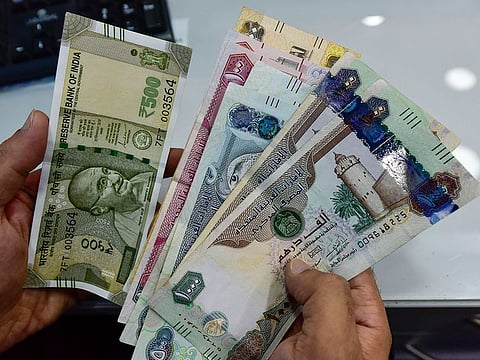Many reasons why UAE banks' interest rates on savings account take time to catch up
Even with multiple rate hikes, those on savings accounts tend to lag

Here’s a quiz question: What is the interest rate on your bank savings account?
Chances are you don’t know the answer. Or don’t remember. Or care. Even if you did, it won’t really matter, since savings interest rates paid by most UAE banks are insignificant.
Since March 2022, the US Federal reserve has raised interest rates as many as 11 times from a low of 0.25 per cent to a high of 5.50 per cent, the highest rate in 22 years, primarily to tame inflation. That’s an unprecedented rise of over 500 basis points within 18 months.
Chances are your friendly neighbourhood bank has not raised your savings rate even once during the same period. In contrast, your loan and mortgage rate might have gone up a few times.
Savings account rates for conventional banks in UAE range from 0.02 per cent per annum to 0.20 per cent. The Big 4 banks pay 0.02 per cent, 0.10 per cent, 0.15 per cent and 0.20 per cent respectively. Most banks have online savings accounts that pay more – up to 2.50 per cent in some cases, based on balances. And then there are digital banks who are painting the town indigo with their billboards announcing 6 per cent rate on savings accounts.
Sharing the joy
So, what’s going on here? Historically, in an increasing interest rate environment, banks pass on only a portion of the interest rate increases to customers on their savings. This proportion, the ratio of the increase in customer savings rates versus the increase in Central Bank short-term base interest rates, is a technical metric called ‘deposit beta’.
For example, a deposit beta of 40 per cent would mean that a bank raised its deposit rates by 40 basis points for a 100 basis point increase in the Central Bank rate. And deposit betas can be calculated for different product types: savings accounts, call accounts and fixed deposits.
How do deposit betas compare between countries? Cumulative deposit betas for US banks vary from 19-69 per cent, the market average being 25 per cent in past 12 months. The same average in the UK is 43 per cent and in Europe 20 per cent. In the UAE, this number is estimated to be 29 per cent, driven primarily by fixed deposits where banks have raised rates steadily unlike in savings accounts.
Typically, banks with a higher proportion of retail deposits have a lower deposit beta than banks with more commercial deposits. Also, deposit betas go up or down during interest rate cycles. In the US for example, they have spiked from 8 per cent in 2022 to 43 per cent in 2023.
Stick or the carrot?
In the UK, there has been strong political and regulatory push recently to pass on interest rate hikes to savers quickly, in view of rising inflation as well as the rapid rise in mortgage interest rates which are floating. As a result, UK banks have handed more of the benefits of interest rate rises to customers than their counterparts in Europe or the US.
International banks are under pressure to pass on the benefits of higher interest rates to their customers. But lenders in less competitive markets have proved far less generous than others, according to an analysis by rating agency S&P.
Analysts believe that after years of extremely low profitability linked to extremely low interest rates, banks now have a chance to recover some of their profitability levels from before the global financial crisis and they are not keen to give that up straightaway.
The rapid interest rate hikes by central bankers over the past 18 months have been a boon for banks, which generate profits from the difference between the rate they pay depositors and what they charge borrowers, known as net interest income. This was reflected in the outstanding half-yearly profit numbers of UAE banks we saw a couple of months back.
Healthy competition is the answer
The Financial Conduct Authority in UK, under pressure from politicians accusing banks of profiteering, recently summoned some of the big banks for a moral suasion session to nudge savings rates higher. But while blaming banks might be easy, it is misguided.
The rates offered by each bank are ultimately based on its specific funding needs. Rather than pressuring banks to raise rates, the focus should be on encouraging competition. While regulators in about 25 countries mandate minimum deposit rates for commercial banks, countries like Kenya and Bangladesh have tried and failed in mandating floor level interest rates for customers. The solution has to be elsewhere – not in regulation.
The Covid-19 lockdowns and government income support schemes has led to a recent surge in excess savings globally. In the UAE for example, savings account balances have grown by 38 per cent - or Dh74 billion - since June 2020.
Flush with funds, there is less incentive for banks to compete for savings by raising rates. Rather than pushing against banks’ business models, regulators are better off trying to boost deposit competition by improving awareness of available products, and making it easier for customers to open and switch to higher-yielding accounts.
Meanwhile, broader access to financial education would also assist savers in shopping for better bank accounts and other investment opportunities. Altogether, this should help increase banks’ incentives to raise rates to retain customers.
With interest rates expected to remain higher for longer, it may be a matter of time before customers see these reflected in their accounts. Encouraging savings will help in building a nest egg that can protect customers, lenders and economies during rainy days.
That certainly is an ‘interest’-ing proposition for banks to consider…
Sign up for the Daily Briefing
Get the latest news and updates straight to your inbox








